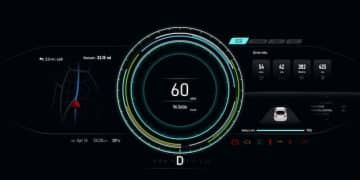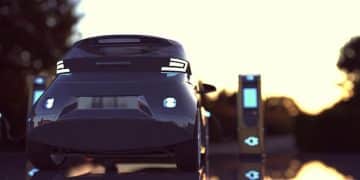Electric Vehicle Autonomous Driving: Comparing Future & Current Systems
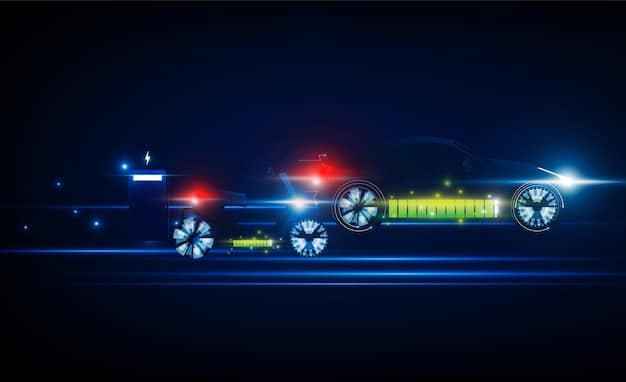
Electric vehicle autonomous driving features are rapidly evolving, with current systems like Tesla’s Autopilot and Cadillac’s Super Cruise offering advanced driver-assistance, while future updates promise full self-driving capabilities with enhanced safety and efficiency.
The automotive industry is undergoing a massive transformation, and at the forefront of this revolution are electric vehicle autonomous driving features: a comparison of current systems and future updates. From enhanced safety to increased convenience, these technologies are poised to redefine our driving experience.
Understanding Current Electric Vehicle Autonomous Driving Systems
Current electric vehicle (EV) autonomous driving systems represent a significant leap forward in automotive technology. These systems are designed to assist drivers, enhance safety, and provide a more convenient driving experience.
Let’s delve into some of the most prominent systems available today.
Tesla Autopilot
Tesla Autopilot is one of the most well-known and widely discussed autonomous driving systems. It uses a suite of cameras, radar, and ultrasonic sensors to provide a range of advanced driver-assistance features.
Cadillac Super Cruise
Cadillac Super Cruise is another leading system that offers hands-free driving capabilities on pre-mapped highways. It uses LiDAR data and high-precision GPS to maintain lane position and adjust speed.
- Key Features: Adaptive cruise control, lane keep assist, automatic lane change, and traffic sign recognition.
- Limitations: Requires driver attention, limited to specific highways, and can be affected by weather conditions.
- User Experience: Generally smooth and reliable, but occasional disengagements can occur, requiring driver intervention.
These systems, while not fully autonomous, represent a significant step towards self-driving vehicles. They offer a glimpse into the future of transportation, where driving is safer, more efficient, and more enjoyable.
The Levels of Autonomous Driving: A Breakdown
Autonomous driving isn’t an all-or-nothing concept. The Society of Automotive Engineers (SAE) has defined six levels of automation, ranging from 0 (no automation) to 5 (full automation). Understanding these levels is crucial for grasping the capabilities and limitations of current and future EV autonomous driving features.
Let’s break down each level to understand the spectrum of automation.
Level 0: No Automation
At this level, the driver is in complete control of the vehicle. There are no automated features, although warning and intervention systems may be present.
Level 1: Driver Assistance
This level introduces basic driver assistance features such as adaptive cruise control or lane keeping assist. The driver must still monitor the driving environment and be prepared to take control at any time.
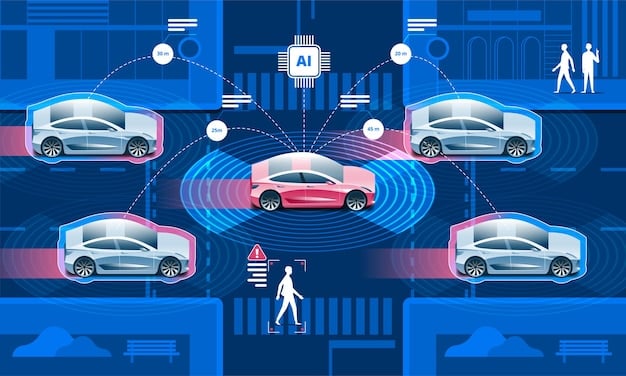
- Level 2: Partial Automation: The vehicle can control both steering and acceleration/deceleration in certain situations. However, the driver must remain attentive and ready to intervene. Tesla Autopilot and Cadillac Super Cruise are examples of Level 2 systems.
- Level 3: Conditional Automation: The vehicle can handle most driving tasks in specific conditions, such as highway driving. The driver can disengage from monitoring the environment but must be prepared to take control when prompted.
- Level 4: High Automation: The vehicle can perform all driving tasks in certain environments. The driver is not expected to intervene, but the vehicle may still have a steering wheel and pedals for manual control.
- Level 5: Full Automation: The vehicle can perform all driving tasks in all conditions. No human intervention is required, and the vehicle may not even have a steering wheel or pedals.
As technology advances, we can expect to see more EVs equipped with Level 3 and Level 4 autonomous driving features, bringing us closer to a future of fully self-driving vehicles.
Comparing Tesla, Cadillac, and Other Key Players
The electric vehicle autonomous driving landscape is filled with major players, each offering unique features and capabilities. Comparing these systems can help you make an informed decision when choosing an EV.
Let’s take a look at some of the key distinctions between Tesla, Cadillac, and other prominent manufacturers.
Tesla Autopilot vs. Cadillac Super Cruise
Tesla Autopilot and Cadillac Super Cruise are often compared due to their advanced driver-assistance features. While both systems offer adaptive cruise control and lane keep assist, there are some key differences.
Tesla Autopilot is more widely available and offers more features, such as automatic lane change and traffic sign recognition. However, it requires constant driver attention and can be prone to disengagements in challenging conditions.
- Mercedes-Benz DRIVE PILOT: A Level 3 system that allows for hands-free driving in specific conditions, such as on certain highways at speeds up to 40 mph.
- BMW Personal Pilot L3: Another Level 3 system that offers similar capabilities to Mercedes-Benz DRIVE PILOT.
- Ford BlueCruise: A Level 2 system that provides hands-free driving on pre-mapped highways, similar to Cadillac Super Cruise.
Each manufacturer is pushing the boundaries of autonomous driving technology, offering consumers an increasing range of options. The best system for you will depend on your individual needs and driving preferences.
Future Updates and Innovations in EV Autonomous Driving
The future of EV autonomous driving is brimming with potential. As technology continues to evolve, we can expect to see even more advanced features and capabilities.
Let’s explore some of the key innovations on the horizon.
Enhanced Sensor Technology
Future autonomous driving systems will rely on more sophisticated sensor technology, including higher-resolution cameras, more advanced radar, and solid-state LiDAR. These sensors will provide a more comprehensive and accurate understanding of the driving environment.
Improved AI and Machine Learning
Artificial intelligence (AI) and machine learning (ML) are playing an increasingly important role in autonomous driving. Future systems will use AI and ML to process sensor data, make decisions, and adapt to changing conditions.
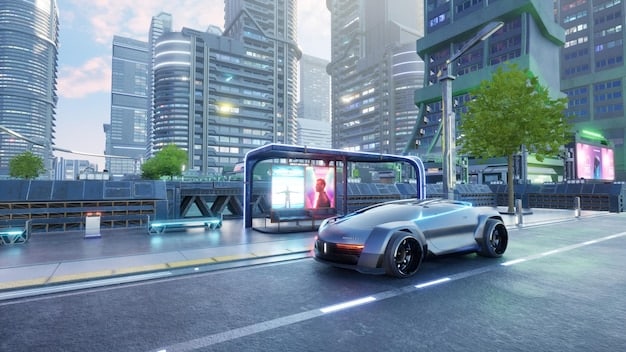
- Over-the-Air (OTA) Updates: EVs can receive software updates wirelessly, allowing manufacturers to continuously improve and enhance autonomous driving features.
- Vehicle-to-Everything (V2X) Communication: V2X technology enables vehicles to communicate with each other and with infrastructure, such as traffic lights and road signs.
- Geofencing: Geofencing allows autonomous driving features to be activated or deactivated based on location.
These future updates and innovations promise to make autonomous driving safer, more efficient, and more convenient than ever before. As technology continues to advance, we can expect to see a significant transformation in the way we drive.
Safety Considerations and Ethical Implications
While autonomous driving technology offers numerous benefits, it also raises important safety considerations and ethical implications. As these systems become more prevalent, it’s crucial to address these concerns.
Let’s consider some of the key challenges and potential solutions.
Cybersecurity Risks
Autonomous vehicles are vulnerable to cybersecurity attacks, which could compromise their safety and security. Manufacturers must implement robust cybersecurity measures to protect against these threats.
Data Privacy
Autonomous vehicles collect vast amounts of data about their surroundings and their occupants. It’s crucial to have clear guidelines and regulations to protect data privacy and prevent misuse.
- Liability in Accidents: Determining liability in accidents involving autonomous vehicles is a complex issue. As these systems become more sophisticated, it’s essential to establish clear legal frameworks for assigning responsibility.
- Ethical Dilemmas: Autonomous vehicles may face ethical dilemmas in certain situations, such as deciding who to protect in an unavoidable collision. These ethical considerations must be carefully addressed and programmed into the system’s decision-making process.
- Public Acceptance: Overcoming public concerns about the safety and reliability of autonomous driving technology is essential for its widespread adoption. Manufacturers and policymakers must work to build trust and confidence in these systems.
By addressing these safety considerations and ethical implications, we can ensure that autonomous driving technology is developed and deployed in a responsible and beneficial manner.
Preparing for the Future of Autonomous EVs
As electric vehicles with autonomous driving features become more common, it’s important to prepare for the future of transportation.
What steps can individuals and communities take to adapt to this changing landscape?
Infrastructure Development
Investing in infrastructure that supports autonomous vehicles, such as high-precision maps and V2X communication networks, is crucial for their successful deployment.
Education and Training
Providing education and training to drivers, policymakers, and the general public about autonomous driving technology can help to alleviate concerns and promote its responsible use.
- Policy and Regulation: Establishing clear and consistent policies and regulations for autonomous vehicles is essential for ensuring their safety and promoting innovation.
- Workforce Transition: The shift to autonomous vehicles may have a significant impact on the workforce, particularly in transportation-related industries.
- Urban Planning: Autonomous vehicles have the potential to transform urban environments, reducing traffic congestion and freeing up parking space.
By taking these steps, we can pave the way for a future where autonomous EVs contribute to a safer, more efficient, and more sustainable transportation system.
| Key Point | Brief Description |
|---|---|
| 🚗 Current Systems | Tesla Autopilot and Cadillac Super Cruise offer advanced driver-assistance. |
| 🤖 Automation Levels | SAE defines six levels, from no automation to full automation. |
| 🔮 Future Updates | Enhanced sensors, AI, OTA updates, and V2X communication are coming. |
| 🛡️ Safety & Ethics | Cybersecurity, data privacy, and liability are crucial considerations. |
Frequently Asked Questions
▼
Tesla Autopilot includes adaptive cruise control, lane keep assist, automatic lane change, and traffic sign recognition, enhancing driving safety and convenience.
▼
Cadillac Super Cruise uses LiDAR data and high-precision GPS for hands-free driving on pre-mapped highways, while Tesla Autopilot relies on cameras and radar.
▼
The six levels range from 0 (no automation) to 5 (full automation), each representing increasing levels of vehicle autonomy and driver assistance.
▼
Future innovations include enhanced sensor technology, improved AI and machine learning, OTA updates, and vehicle-to-everything (V2X) communication.
▼
Key considerations include cybersecurity risks, data privacy, liability in accidents, and ethical dilemmas to ensure responsible development and deployment.
Conclusion
As we conclude this exploration of electric vehicle autonomous driving features, it’s clear that the technology is rapidly advancing, offering both current enhancements and promising future updates. From the advanced driver-assistance systems of today to the fully autonomous vehicles of tomorrow, the journey towards safer, more efficient, and more convenient transportation is well underway, requiring ongoing attention to safety, ethics, and infrastructure development.
